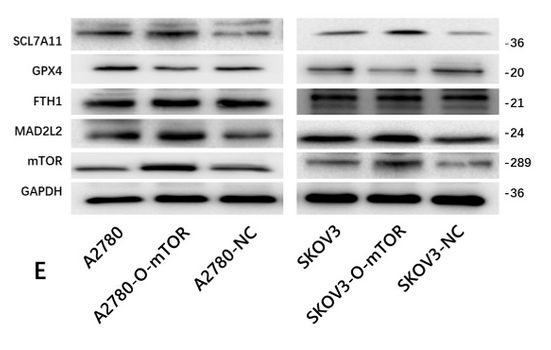MAD2L2 Antibody - #DF12288
製品説明
*The optimal dilutions should be determined by the end user. For optimal experimental results, antibody reuse is not recommended.
*Tips:
WB: For western blot detection of denatured protein samples. IHC: For immunohistochemical detection of paraffin sections (IHC-p) or frozen sections (IHC-f) of tissue samples. IF/ICC: For immunofluorescence detection of cell samples. ELISA(peptide): For ELISA detection of antigenic peptide.
引用形式: Affinity Biosciences Cat# DF12288, RRID:AB_2845093.
折りたたみ/展開
Homolog of REV7 S cerevisiae; hREV7; MAD2 (mitotic arrest deficient yeast, homolog) like 2; MAD2 homolog; MAD2 like 2; MAD2 mitotic arrest deficient like 2; MAD2-like protein 2; MAD2B; Mad2l2; MD2L2_HUMAN; Mitotic Arrest Deficient 2 L2; Mitotic arrest deficient 2-like protein 2; Mitotic arrest deficient homolog like 2; Mitotic arrest deficient like 2 (yeast); Mitotic arrest deficient yeast homolog; Mitotic spindle assembly checkpoint protein MAD2B; Polymerase (DNA directed) zeta 2 accessory subunit; POLZ2; REV 7; REV7; REV7 homolog; Weakly similar to Mitotic MAD2 protein (S cerevisiae);
免疫原
A synthesized peptide derived from human MAD2L2, corresponding to a region within the internal amino acids.
- Q9UI95 MD2L2_HUMAN:
- Protein BLAST With
- NCBI/
- ExPASy/
- Uniprot
MTTLTRQDLNFGQVVADVLCEFLEVAVHLILYVREVYPVGIFQKRKKYNVPVQMSCHPELNQYIQDTLHCVKPLLEKNDVEKVVVVILDKEHRPVEKFVFEITQPPLLSISSDSLLSHVEQLLRAFILKISVCDAVLDHNPPGCTFTVLVHTREAATRNMEKIQVIKDFPWILADEQDVHMHDPRLIPLKTMTSDILKMQLYVEERAHKGS
種類予測
Score>80(red) has high confidence and is suggested to be used for WB detection. *The prediction model is mainly based on the alignment of immunogen sequences, the results are for reference only, not as the basis of quality assurance.
High(score>80) Medium(80>score>50) Low(score<50) No confidence
研究背景
Adapter protein able to interact with different proteins and involved in different biological processes. Mediates the interaction between the error-prone DNA polymerase zeta catalytic subunit REV3L and the inserter polymerase REV1, thereby mediating the second polymerase switching in translesion DNA synthesis. Translesion DNA synthesis releases the replication blockade of replicative polymerases, stalled in presence of DNA lesions. Component of the shieldin complex, which plays an important role in repair of DNA double-stranded breaks (DSBs). During G1 and S phase of the cell cycle, the complex functions downstream of TP53BP1 to promote non-homologous end joining (NHEJ) and suppress DNA end resection. Mediates various NHEJ-dependent processes including immunoglobulin class-switch recombination, and fusion of unprotected telomeres. May also regulate another aspect of cellular response to DNA damage through regulation of the JNK-mediated phosphorylation and activation of the transcriptional activator ELK1. Inhibits the FZR1- and probably CDC20-mediated activation of the anaphase promoting complex APC thereby regulating progression through the cell cycle. Regulates TCF7L2-mediated gene transcription and may play a role in epithelial-mesenchymal transdifferentiation.
Nucleus. Cytoplasm>Cytoskeleton>Spindle. Cytoplasm. Chromosome.
Note: Recruited to sites of chromosomal double-stranded breaks during G1 and S phase of the cell cycle.
Ubiquitously expressed.
研究領域
· Cellular Processes > Cell growth and death > Cell cycle. (View pathway)
· Cellular Processes > Cell growth and death > Oocyte meiosis. (View pathway)
· Human Diseases > Infectious diseases: Bacterial > Bacterial invasion of epithelial cells.
· Human Diseases > Infectious diseases: Bacterial > Shigellosis.
· Organismal Systems > Endocrine system > Progesterone-mediated oocyte maturation.
参考文献
Application: WB Species: Human Sample:
Application: WB Species: Human Sample:
Restrictive clause
Affinity Biosciences tests all products strictly. Citations are provided as a resource for additional applications that have not been validated by Affinity Biosciences. Please choose the appropriate format for each application and consult Materials and Methods sections for additional details about the use of any product in these publications.
For Research Use Only.
Not for use in diagnostic or therapeutic procedures. Not for resale. Not for distribution without written consent. Affinity Biosciences will not be held responsible for patent infringement or other violations that may occur with the use of our products. Affinity Biosciences, Affinity Biosciences Logo and all other trademarks are the property of Affinity Biosciences LTD.




